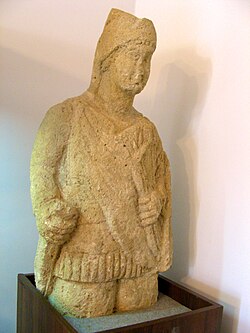Sindi people
 From Wikipedia - Reading time: 8 min
From Wikipedia - Reading time: 8 min
The Sindi (Ancient Greek: Σίνδοι, romanized: Síndoi; Latin: Sindi) were an ancient Scythian people who primarily lived in western Ciscaucasia. A portion of the Sindi also lived in Central Europe. Their name is variously written, and Pomponius Mela calls them Sindones, while Lucian calls them Sindianoi.
History
[edit]Ciscaucasia
[edit]Sindica | |||||||||
|---|---|---|---|---|---|---|---|---|---|
| c. 7th century BC–c. 380 BC | |||||||||
| Common languages | Scythian Maeotian Ancient Greek | ||||||||
| Religion | Scythian religion Maeotian religion Ancient Greek religion | ||||||||
| Government | Monarchy | ||||||||
| King | |||||||||
| Historical era | Iron Age Scythian culture | ||||||||
• Scythian retreat from Ciscaucasia | c. 7th century BC | ||||||||
• Conquest by the Bosporan Kingdom | c. 380 BC | ||||||||
| |||||||||
| Today part of | Southern Russia | ||||||||


The Sindi were a tribe of the Scythians who established themselves on the Taman peninsula,[1] where they formed a ruling class over the indigenous North Caucasian Maeotians. Archaeologically, the Sindi belonged to the Scythian culture, and they progressively became Hellenised due to contact with the Bosporan Kingdom.[2]
As the Scythians lost more territory in Ciscaucasia to the Sauromatians over the course of the late 6th century BC, the Sindi remained the only Scythian group still present in the region, in the area called Sindica (Ancient Greek: Σινδική, romanized: Sindikḗ; Latin: Sindica) by the Greeks and which corresponded to the area west of present-day Krasnodar, in the Taman peninsula.[2]
The kingdom of Sindica existed for only a brief time, and it was soon annexed by the Bosporan Kingdom.[2]
Central Europe
[edit]Unlike the majority of the Sindi, who remained in the northern Caucasus, a smaller section of the Sindi migrated westwards and settled into the Hungarian Plain as part of the expansion of the Scythian into Central Europe during the 7th to 6th centuries BC, and they soon lost contact with the Scythians who remained in the Pontic Steppe. The 3rd century BC Greek author Apollonius of Rhodes located a population of the Sindi living alongside the Sigynnae and the otherwise unknown Grauci in the "plain of Laurion", which is likely the eastern part of the Pannonian Basin.[3][4][1]
Archaeology
[edit]North Caucasus
[edit]The Scythian ruling class in the Maeotian country initially buried their dead in kurgans while the native Maeotian populace were buried in flat cemeteries. Burials in Sindica continued this tradition, and members of the Sindi ruling class continued being buried in kurgans while the Maeotians continued to be buried in flat graves.[2]
After earlier Scythian earthworks built in the 6th century BC along the right bank of the Kuban river were abandoned in the 4th century BC, when the Sauromatians took over most of Ciscaucasia, the Sindi built a new series of earthworks on their eastern borders. One of the Sindi earthworks was located at Yelizavetinskaya, where was located a c. 400 BC kurgan in which several humans were buried and which contained the skeletons of 200 horses.[2]
Genetics
[edit]The Hungarian Sindi had almost equal proportions of Neolithic origin and steppe, associated with the Yamnaya culture; there is also a minor contribution of WHG.[5][6]

References
[edit]Citations
[edit]- ^ a b Olbrycht 2000.
- ^ a b c d e Sulimirski & Taylor 1991, pp. 568–573.
- ^ Sulimirski 1985, pp. 191–193.
- ^ Batty, Roger (2007). Rome and the Nomads: The Pontic-Danubian Realm in Antiquity. Oxford: Oxford University Press. ISBN 978-0-198-14936-1.
- ^ Damgaard, P. B.; et al. (9 May 2018). "137 ancient human genomes from across the Eurasian steppes". Nature. 557 (7705). Nature Research: 369–373. Bibcode:2018Natur.557..369D. doi:10.1038/s41586-018-0094-2. hdl:1887/3202709. PMID 29743675. S2CID 13670282. Retrieved 11 April 2020.
- ^ Allentoft, Morten E.; Sikora, Martin; Refoyo-Martínez, Alba; Irving-Pease, Evan K.; Fischer, Anders; Barrie, William; Ingason, Andrés; Stenderup, Jesper; Sjögren, Karl-Göran; Pearson, Alice; Sousa da Mota, Bárbara; Schulz Paulsson, Bettina; Halgren, Alma; Macleod, Ruairidh; Jørkov, Marie Louise Schjellerup (January 2024). "Population genomics of post-glacial western Eurasia". Nature. 625 (7994): 301–311. Bibcode:2024Natur.625..301A. doi:10.1038/s41586-023-06865-0. ISSN 1476-4687. PMC 10781627. PMID 38200295.
Sources
[edit]- Olbrycht, Marek Jan (2000). "Remarks on the Presence of Iranian Peoples in Europe and Their Asiatic Relations". Collectanea Celto-Asiatica Cracoviensia. Kraków: Księgarnia Akademicka. pp. 105–107. ISBN 978-8-371-88337-8.
- Sulimirski, T. (1985). "The Scyths". In Gershevitch, I. (ed.). The Cambridge History of Iran. Vol. 2. Cambridge University Press. pp. 149–199. ISBN 978-1-139-05493-5.
- Sulimirski, Tadeusz; Taylor, T. F. (1991). "The Scythians". In Boardman, John; Edwards, I. E. S.; Hammond, N. G. L.; Sollberger, E.; Walker, C. B. F. (eds.). The Cambridge Ancient History. Vol. 3.2. Cambridge: Cambridge University Press. pp. 560–590. ISBN 978-1-139-05429-4.
- Trubachov, Oleg N., 1999: Indoarica, Nauka, Moscow.
 KSF
KSF